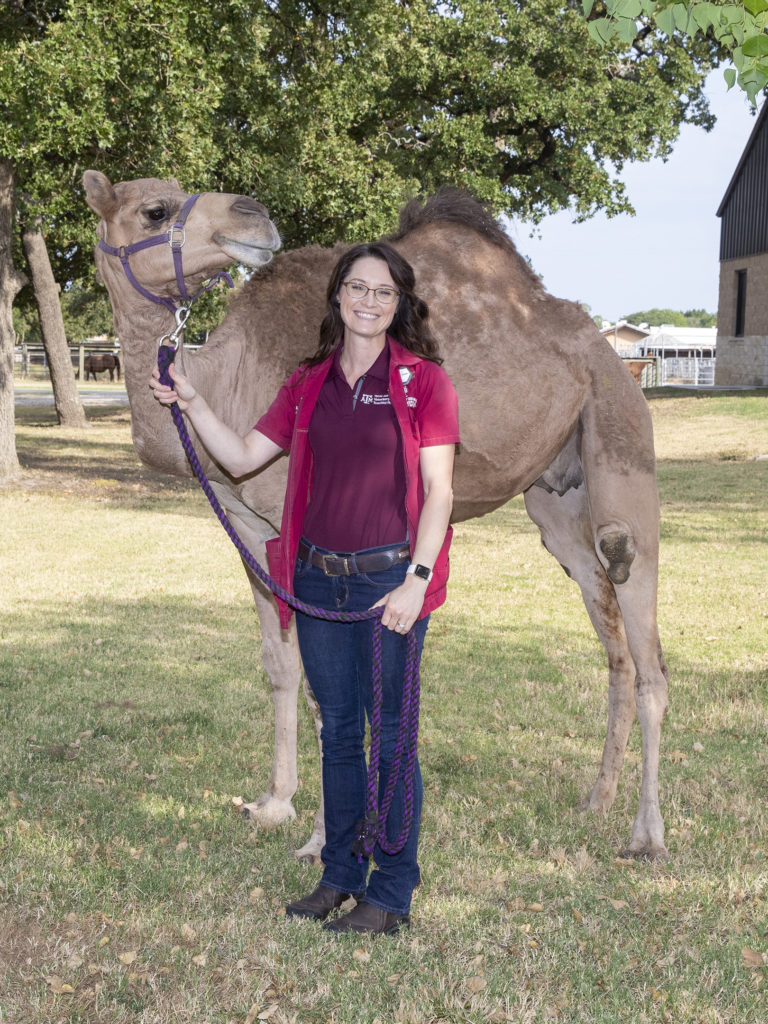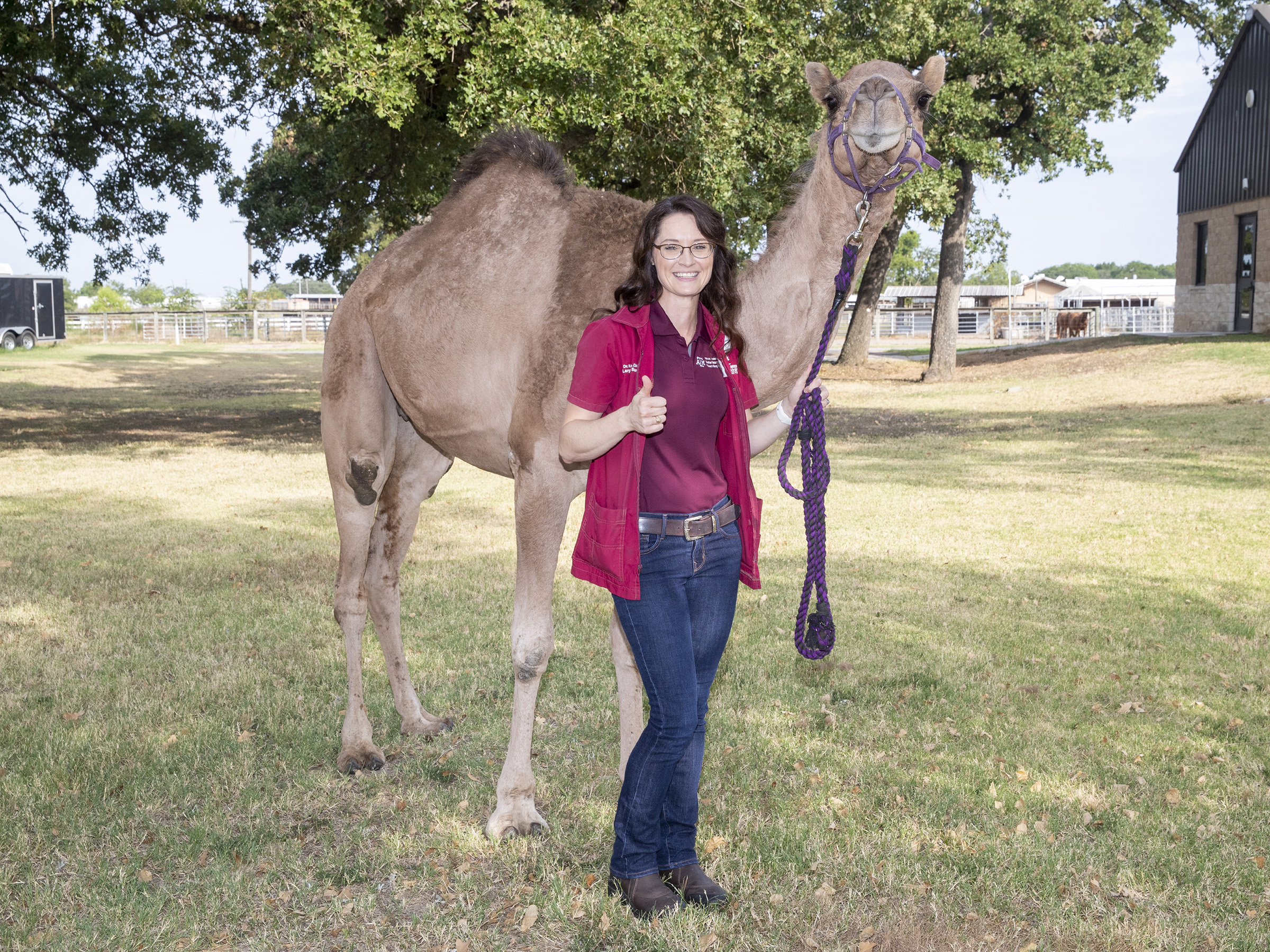Texas A&M Large Animal Surgeons Save Camel With Dislocated Hip
Story by Megan Myers, CVMBS Communications

When Sybil the camel arrived at the Texas A&M Large Animal Hospital with a serious hip injury, very few believed that a successful surgery would be possible. Luckily, thanks to the faith of her owners and skill of her surgical team, Sybil has become one of the first camels to fully recover from a dislocated hip.
The Texas A&M Veterinary Medical Teaching Hospital’s (VMTH) Large Animal Hospital (LAH) may mostly treat horses and farm animals, but other species are also seen surprisingly often, including a large number of camels that live as pets on Texas ranches.
When Sybil, a 7-year-old dromedary (one-humped) camel, arrived at the LAH, she could barely walk on her left hind leg. Radiographs quickly revealed the problem—the camel’s hip joint was dislocated out of its socket and her femur had moved far away from her pelvis.
“This coxofemoral luxation diagnosis was heartbreaking because the options for treatment are limited and prognosis is poor for adult large animals with this condition,” said Dr. Kati Glass, a clinical assistant professor in large animal surgery. “Basically, the bigger the animal, the harder it is to get the hip back in its socket and the harder it is to keep it there.”
Glass consulted with other veterinary surgeons to discuss Sybil’s predicament, but their recommendations were disheartening. The consensus was that there was very little chance for surgery to be successful, meaning that Sybil would likely live a life of discomfort because of the injury and, therefore, should be put down.
Sybil’s owner, Dr. Ron McMurry, however, insisted that Glass and her team do whatever they could to try to save Sybil’s life.
“It felt like I was in Las Vegas and I had bet my last hundred dollars,” McMurry said, “but I felt the need to try something.”
McMurry may have felt nervous going into surgery, but he was also very optimistic that Glass and her team would be able to fix Sybil’s hip.
“Dr. McMurry gave us the chance to go to surgery and to move forward if things went well, but also to be mindful of her care and comfort in that if we weren’t successful, then we knew that we had tried,” Glass said. “That put us in a position to give it our all because without the surgery, we knew Sybil didn’t have a good chance at a comfortable life; so, really, we didn’t have much to lose.”
Joined by large animal surgery residents Drs. Lauren Richardson and Alyssa Doering, fourth-year veterinary students Shanna Keshvari and Amanda Armendariz, and a team of anesthesia specialists—including Drs. Mauricio Lepiz and Courtney Baetge, with anesthesia resident Dr. Sarah Jarosinski—Glass began the surgery to fix the camel’s dislocated hip.
Finally, just as the team was becoming fearful that their efforts may not be successful, the joint fell back into place with a loud pop.
“It was this huge, celebratory moment,” Glass said. “Then, the even more difficult part started for us as surgeons, because then I knew I had to do something to try to keep it there.”
She secured the joint in place with screws and a stainless-steel cable, but radiographs taken two days after surgery showed that the implants had broken. Thankfully, despite the failure of the cable, Sybil’s hip was still in place.

Glass and her team were thrilled with this success. Also thrilling was the fact that Sybil was bright, eating, and recovering smoothly.
They also had one other reason to celebrate—Sybil was expecting a baby.
“We knew at the time of surgery that she had been recently bred, but we were focused on saving Sybil’s life at that time,” Glass said. “After surgery, as we saw Sybil recovering, we confirmed that she was still pregnant!”
For now, Sybil is continuing her rest and rehabilitation at the LAH.
Glass said Sybil has been the perfect patient, especially since she is trained to lay down, stand up, and move around on command. During her time at the LAH, Sybil used her charm on everyone she met, even influencing veterinary students to throw her a camel-themed baby shower.
For Glass, the McMurry family’s commitment was the critical component that allowed the chance to save Sybil’s life and to learn valuable information about treating other camels with hip dislocations.
“Every time we have the opportunity to take a chance on a procedure like this, we learn something,” Glass said. “What I’ve learned throughout Sybil’s care will help me even more in the next case.”
Glass is hopeful that when a similar case comes to her or another veterinarian in the future, they can provide the owner with more options and be more optimistic about the potential outcome.
“Sybil’s success gives us that opportunity to say it can work and we should try,” she said.
Sybil will soon return to her ranch in Jasper, Texas, to finishing recovering and have her baby at home.
While it’s common for hips to reluxate (or come back out of socket) in large animals after surgery, Glass said that with each day that passes, she is more optimistic about the joint staying in place for the rest of Sybil’s life.
###
For more information about the Texas A&M College of Veterinary Medicine & Biomedical Sciences, please visit our website at vetmed.tamu.edu or join us on Facebook, Instagram, and Twitter.
Contact Information: Jennifer Gauntt, Interim Director of CVM Communications, Texas A&M College of Veterinary Medicine & Biomedical Science; jgauntt@cvm.tamu.edu; 979-862-4216


